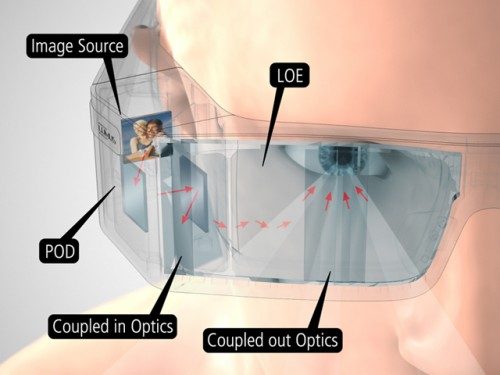 Lumus is an Israel based company that’s manufactures components for head mounted displays. Specifically, they’re offering what they call the ‘Optical Engine Module’, a display which uses ‘LOE’ (Light-guided Optical Element) technology to enable a lightweight head mounted display solution that’s fully transparent. The transparency means that Lumus is thinking about augmented reality applications for their product, rather than strictly gaming or cinema use.
Lumus is an Israel based company that’s manufactures components for head mounted displays. Specifically, they’re offering what they call the ‘Optical Engine Module’, a display which uses ‘LOE’ (Light-guided Optical Element) technology to enable a lightweight head mounted display solution that’s fully transparent. The transparency means that Lumus is thinking about augmented reality applications for their product, rather than strictly gaming or cinema use.
For now, Lumus isn’t selling any products to consumers. Instead, they offer the Optical Engine Module to other companies for incorporation into products with different branding (much like many HDTV manufacturers actually use screens made by a single company). In addition to selling the Optical Engine Module to companies, Lumus offers a DDK (display development kit) for manufacturers to test the product.
The DDK uses two of the Optical Engine Modules (one for each eye), and is actually fairly attractive if you ask me. Each Optical Engine Module (let’s call them OEM for short) has a resolution of 720p and uses ‘LOE’ technology which allows the image to be projected from the side of the head rather than directly in front. The light is guided from the side of the head through the lens and into the eye:
I must say, if this LOE technology works as advertised, Lumus might have something on their hands here. They’ve found a lightweight solution that also offers a high level of transparency. Being a stereo display (two screens) also means that it’s naturally capable of 3D. The lenses are a mere 1.6mm thick which means they have the potential to look like relatively normal glasses. Here are the specs for the OEM (the OE-32 specifically), according to Lumus:
| Display format | 720p 1280 x 720 pixels |
| Field of View | 40° |
| Virtual screen size | Equivalent of 87″ screen at 10 ft away; 870″ at 100 ft away |
| Eye motion box | 10 x 8 mm |
| Display color | Full color |
| Transparency | >78% |
| Brightness | >1,000 FtL |
| Contrast ratio | >250:1 |
| Eye relief | 22 mm |
| Weight | 26g |
| LOE thickness | 1.6 mm |
Because Lumus is not selling directly to consumers at this point, they don’t have storefront pricing available. I’m looking forward to seeing the firm consumer-available product based on Lumus’ OEM and LOE technology. If they want to compete with Silicon Micro Display’s ST1080 and the Sony HMZ-T1, then it’ll have to be under $799. Stay tuned, I’ll be watching these guys.








Pingback: Google Announces Project Glass, Wants to Bring Augmented Reality and Wearable Computing to the Masses [video] « Road to Virtual Reality()